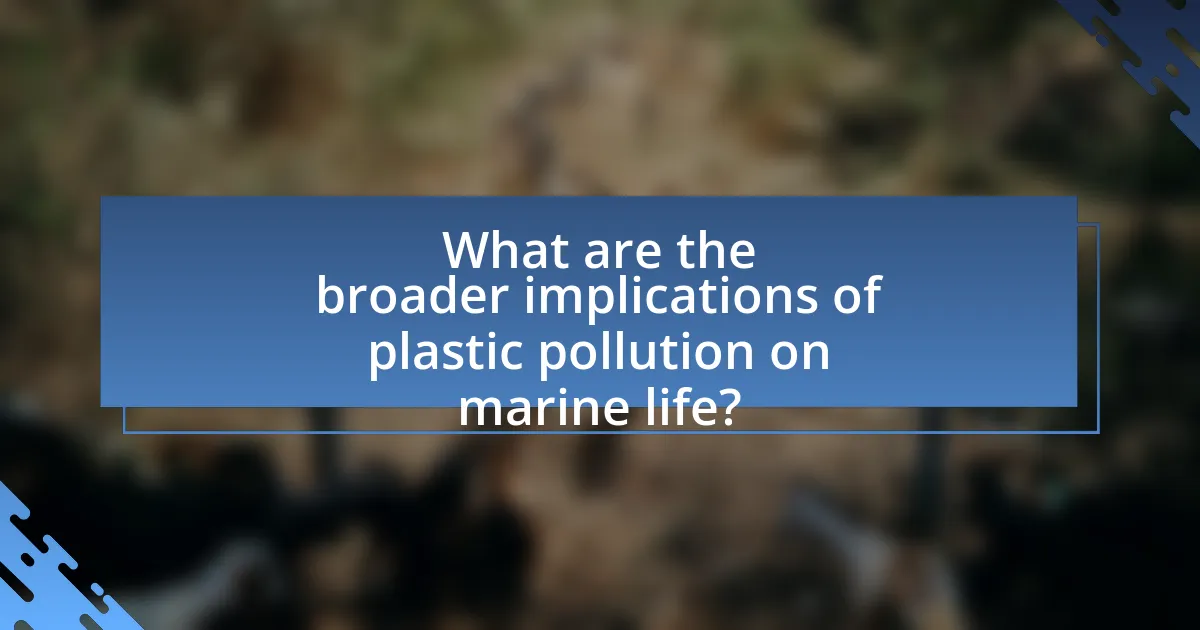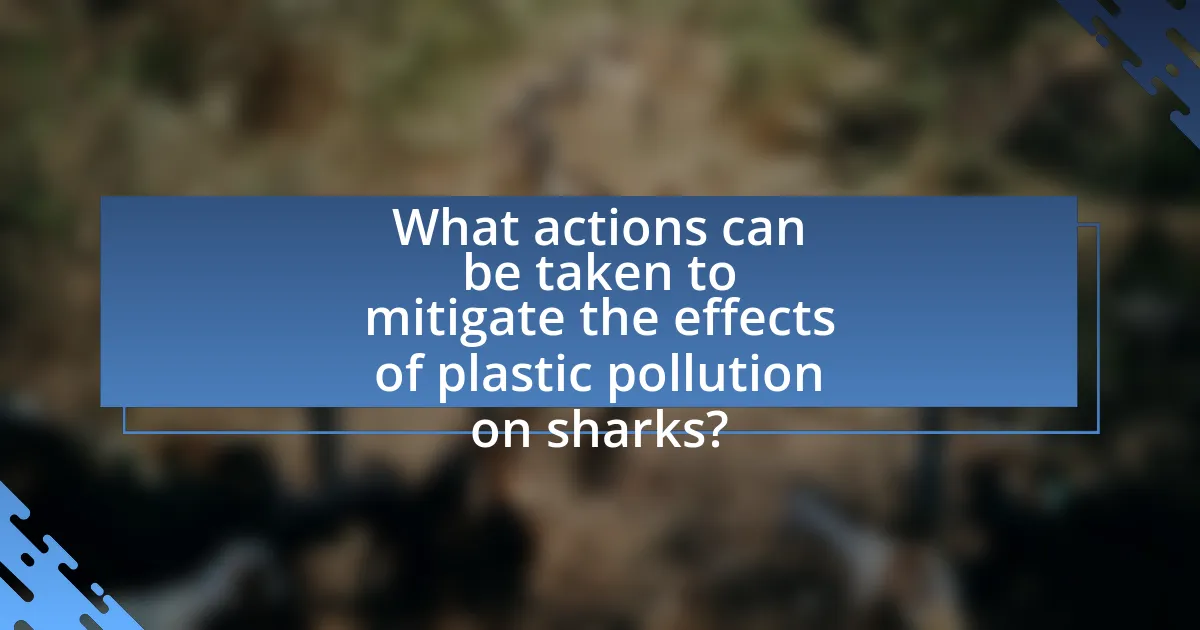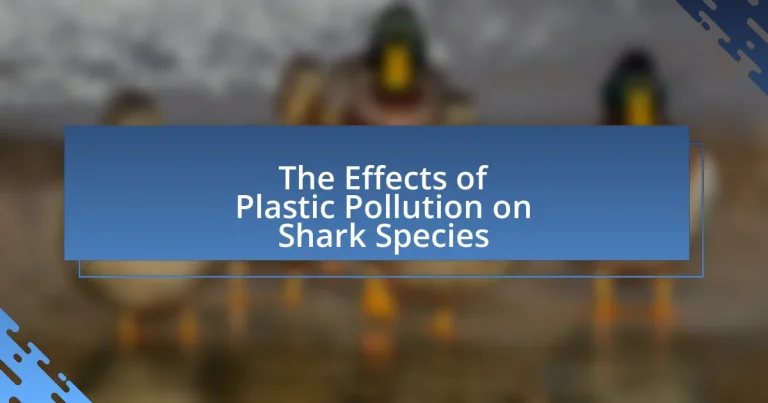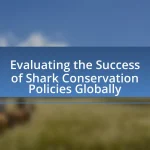Plastic pollution poses significant threats to shark species, causing physical harm, malnutrition, and reproductive issues through the ingestion of toxic materials and disruption of their ecosystems. Over 100 species of sharks have been documented with plastic in their stomachs, leading to health complications and decreased reproductive success. The degradation of shark habitats due to plastic waste further impacts prey availability and alters natural behaviors, ultimately threatening shark populations. This article explores the various effects of plastic pollution on sharks, including the types of plastics that are most harmful, the physiological consequences of ingestion, and the broader implications for marine ecosystems and economies reliant on healthy shark populations. Additionally, it discusses potential strategies for mitigating these effects and raising awareness about the importance of shark conservation in polluted waters.

What are the effects of plastic pollution on shark species?
Plastic pollution adversely affects shark species by causing physical harm, ingestion of toxic materials, and disruption of their ecosystems. Sharks often mistake plastic debris for prey, leading to ingestion that can cause internal injuries, blockages, or even death. Research indicates that over 100 species of sharks have been found with plastic in their stomachs, which can lead to malnutrition and reduced reproductive success. Additionally, the presence of microplastics in marine environments can disrupt the food chain, affecting the availability of prey for sharks and altering their habitats. Studies have shown that plastic pollution can also lead to increased exposure to harmful chemicals, which can accumulate in shark tissues and impact their health and reproductive capabilities.
How does plastic pollution impact shark habitats?
Plastic pollution significantly degrades shark habitats by introducing harmful materials into marine ecosystems. Sharks are affected by the ingestion of plastic debris, which can lead to physical harm, malnutrition, and even death. Research indicates that over 700 species, including various sharks, have been documented to ingest plastic, leading to severe health issues. Additionally, plastic pollution disrupts the delicate balance of marine environments, affecting prey availability and habitat quality, which are crucial for shark survival. Studies have shown that microplastics can accumulate in the food chain, further impacting shark populations by reducing their food sources and altering their natural behaviors.
What specific types of plastic are most harmful to sharks?
Microplastics and larger plastic debris, such as fishing nets and lines, are the specific types of plastic most harmful to sharks. Microplastics can be ingested by sharks, leading to internal injuries and potential toxicity from chemical contaminants. Larger plastic debris, particularly discarded fishing gear, poses a significant threat through entanglement, which can cause injury or death. Research indicates that over 100,000 marine animals, including sharks, die each year due to entanglement in fishing gear, highlighting the severe impact of plastic pollution on these species.
How do changes in habitat affect shark behavior and survival?
Changes in habitat significantly affect shark behavior and survival by altering their feeding patterns, reproductive success, and overall health. For instance, the introduction of plastic pollution into marine environments can lead to habitat degradation, which disrupts the availability of prey and suitable breeding grounds for sharks. Research indicates that sharks exposed to polluted habitats exhibit increased stress levels and altered foraging behaviors, which can reduce their survival rates. A study published in the journal “Marine Pollution Bulletin” found that sharks in areas with high plastic concentrations showed a 30% decrease in successful hunting attempts compared to those in cleaner environments. This evidence underscores the critical link between habitat quality and shark behavior, highlighting the detrimental impact of pollution on their survival.
What are the physiological effects of plastic ingestion on sharks?
Plastic ingestion in sharks leads to several detrimental physiological effects, including gastrointestinal blockages, malnutrition, and potential toxicity. When sharks consume plastic, it can obstruct their digestive tracts, causing pain and preventing the absorption of nutrients. Research indicates that ingested plastics can also leach harmful chemicals into the sharks’ systems, which may disrupt endocrine functions and lead to reproductive issues. A study published in the journal “Marine Pollution Bulletin” by Gall and Thompson (2015) highlights that microplastics can accumulate in the tissues of marine organisms, including sharks, further exacerbating health risks.
How does plastic ingestion affect shark health and reproduction?
Plastic ingestion negatively impacts shark health and reproduction by causing physical harm and introducing toxic substances into their bodies. Sharks that consume plastic may experience internal injuries, blockages, and malnutrition, which can lead to decreased overall health. Furthermore, the ingestion of microplastics can result in the accumulation of harmful chemicals, such as heavy metals and persistent organic pollutants, which disrupt endocrine functions and reproductive processes. Research indicates that these toxic substances can impair reproductive success, leading to reduced fertility and abnormal development in embryos. Studies have shown that sharks exposed to high levels of pollutants exhibit altered hormone levels, which can further compromise their reproductive capabilities.
What are the long-term consequences of plastic pollution on shark populations?
Plastic pollution has significant long-term consequences on shark populations, primarily through ingestion and habitat degradation. Sharks often mistake plastic debris for prey, leading to ingestion that can cause internal injuries, malnutrition, and even death. Research indicates that over 100 species of sharks have been found with plastic in their stomachs, which disrupts their digestive systems and can lead to decreased reproductive success. Additionally, plastic pollution contributes to habitat degradation, particularly in coastal areas where sharks breed and feed. The presence of microplastics in these environments can alter the availability of prey species and disrupt the overall ecosystem balance, further threatening shark populations.
How does plastic pollution influence shark prey availability?
Plastic pollution negatively influences shark prey availability by disrupting marine ecosystems and food webs. The ingestion of plastic by smaller marine organisms, which are primary prey for sharks, leads to decreased populations of these species. For instance, studies have shown that microplastics can accumulate in the bodies of fish and invertebrates, affecting their health and reproductive capabilities, ultimately reducing their numbers. Additionally, plastic debris can alter habitats, making them less suitable for prey species, further diminishing their availability to sharks.
What role do sharks play in the marine ecosystem affected by plastic pollution?
Sharks serve as apex predators in the marine ecosystem, playing a crucial role in maintaining the balance of marine life, even in environments affected by plastic pollution. Their predation helps regulate the populations of various species, which can be disrupted by the presence of plastic debris that alters habitats and food sources. For instance, studies have shown that plastic pollution can lead to a decline in prey species, which in turn affects shark populations and their ability to fulfill their ecological role. Additionally, sharks can ingest plastic, leading to health issues that further impact their populations and, consequently, the overall health of the marine ecosystem.
How does the decline in shark populations due to plastic pollution affect other marine species?
The decline in shark populations due to plastic pollution negatively impacts other marine species by disrupting the marine food web. Sharks are apex predators, and their reduction leads to an increase in the populations of smaller predatory fish, which can overconsume herbivorous species. This overconsumption can result in the decline of important algae and seagrass ecosystems, which are vital for carbon sequestration and habitat for various marine organisms. Research indicates that the loss of sharks can lead to a trophic cascade, where the balance of marine ecosystems is significantly altered, affecting biodiversity and the overall health of ocean environments.

What are the broader implications of plastic pollution on marine life?
Plastic pollution has severe broader implications on marine life, significantly affecting ecosystems and species interactions. Marine organisms, including sharks, ingest plastic debris, leading to physical harm, malnutrition, and toxic exposure from chemicals leaching into their bodies. Research indicates that over 800 species are affected by marine debris, with ingestion and entanglement being the primary threats. For instance, a study published in the journal “Marine Pollution Bulletin” found that 73% of shark species examined had ingested plastic, which can disrupt their feeding behavior and reproductive success. Additionally, the accumulation of microplastics in the food chain poses risks to predator species, including sharks, as toxins concentrate at higher trophic levels, ultimately impacting biodiversity and ecosystem health.
How does plastic pollution affect the food chain in marine ecosystems?
Plastic pollution disrupts the food chain in marine ecosystems by introducing harmful materials that can be ingested by marine organisms. When marine animals, including fish and invertebrates, consume plastic debris, it can lead to physical blockages, malnutrition, and exposure to toxic substances. For instance, a study published in the journal “Marine Pollution Bulletin” found that over 800 species are affected by marine debris, with many species mistaking plastic for food. This ingestion can bioaccumulate toxins in predators, including sharks, which are higher up in the food chain. Consequently, the presence of plastic not only impacts individual species but also alters the dynamics of entire marine ecosystems, affecting biodiversity and food availability.
What are the consequences of microplastics on marine organisms?
Microplastics have detrimental consequences on marine organisms, including physical harm, toxicological effects, and disruption of ecological balance. Marine organisms ingest microplastics, leading to internal injuries, reduced feeding efficiency, and impaired growth. Studies have shown that microplastics can carry harmful pollutants, which may accumulate in the tissues of marine species, causing toxic effects that can affect reproduction and survival rates. For instance, research published in Environmental Science & Technology found that microplastics can cause oxidative stress in marine organisms, leading to cellular damage. Additionally, the presence of microplastics in the food web can disrupt predator-prey relationships, ultimately affecting biodiversity and ecosystem health.
How do changes in marine biodiversity impact sharks specifically?
Changes in marine biodiversity significantly impact sharks by altering their prey availability and habitat conditions. As biodiversity declines, the populations of smaller fish and invertebrates that sharks rely on for food may decrease, leading to nutritional stress and reduced reproductive success in shark species. For instance, studies have shown that overfishing and habitat degradation can lead to a decline in key prey species, which directly affects shark populations. Additionally, changes in biodiversity can disrupt the ecological balance, leading to shifts in predator-prey dynamics that further threaten shark survival.
What are the economic impacts of declining shark populations due to plastic pollution?
Declining shark populations due to plastic pollution negatively impact economies reliant on marine ecosystems. Sharks play a crucial role in maintaining the balance of marine life, which supports fisheries and tourism industries. For instance, the global shark-related tourism industry is valued at approximately $314 million annually, highlighting the economic significance of healthy shark populations. Furthermore, the decline in sharks can lead to overpopulation of prey species, disrupting local fisheries and resulting in decreased fish stocks, which can harm the livelihoods of fishing communities. Studies indicate that a reduction in apex predators like sharks can lead to a 50% decline in fishery yields, demonstrating the direct economic consequences of their decline due to plastic pollution.
How does the decline of sharks affect fisheries and tourism industries?
The decline of sharks negatively impacts fisheries and tourism industries by disrupting marine ecosystems and reducing biodiversity. Sharks play a crucial role as apex predators, helping to maintain the balance of marine life. Their decline can lead to an overpopulation of smaller fish species, which can deplete fish stocks that are vital for commercial fisheries. For instance, a study published in the journal “Marine Ecology Progress Series” found that the removal of sharks can lead to a 50% decline in commercially important fish populations.
In terms of tourism, many regions rely on shark-related activities, such as diving and eco-tourism, which generate significant revenue. The loss of shark populations can diminish the attractiveness of these destinations, leading to decreased tourist numbers. According to the “Shark Conservation Society,” shark-related tourism is worth over $220 million annually in the Bahamas alone. Thus, the decline of sharks has direct economic repercussions for both fisheries and tourism sectors.
What are the potential costs of inaction regarding plastic pollution on marine life?
The potential costs of inaction regarding plastic pollution on marine life include significant declines in biodiversity, disruption of marine ecosystems, and economic losses in fisheries and tourism. Marine species, including sharks, are particularly vulnerable as they ingest plastic debris, leading to health issues and increased mortality rates. Research indicates that over 800 species are affected by marine debris, with sharks facing threats from entanglement and ingestion of plastics, which can result in starvation or internal injuries. The economic impact is substantial; for instance, the global cost of plastic pollution in marine environments is estimated to reach $13 billion annually, affecting industries reliant on healthy marine ecosystems.

What actions can be taken to mitigate the effects of plastic pollution on sharks?
To mitigate the effects of plastic pollution on sharks, implementing comprehensive waste management systems is essential. Effective waste management reduces the amount of plastic entering marine environments, thereby decreasing the likelihood of sharks ingesting or becoming entangled in plastic debris. Research indicates that over 100 million marine animals, including sharks, die each year due to plastic pollution, highlighting the urgency of this action. Additionally, promoting public awareness campaigns about the dangers of plastic pollution can lead to behavioral changes that further reduce plastic waste. These actions collectively contribute to the protection of shark populations and their habitats.
What are effective strategies for reducing plastic waste in oceans?
Effective strategies for reducing plastic waste in oceans include implementing comprehensive waste management systems, promoting recycling initiatives, and enforcing stricter regulations on plastic production and usage. Comprehensive waste management systems can significantly decrease the amount of plastic entering marine environments; for instance, cities with efficient waste collection and recycling programs have reported reductions in litter by up to 30%. Promoting recycling initiatives encourages consumers to participate in reducing plastic waste, as evidenced by studies showing that increased public awareness campaigns can lead to a 20% rise in recycling rates. Additionally, enforcing stricter regulations on plastic production, such as bans on single-use plastics, has been successfully adopted in various countries, leading to a measurable decrease in ocean plastic pollution, with some regions reporting a 50% reduction in plastic waste within a few years of implementation.
How can individuals contribute to reducing plastic pollution?
Individuals can contribute to reducing plastic pollution by minimizing their use of single-use plastics. This can be achieved by opting for reusable bags, bottles, and containers, which significantly decreases the demand for plastic products. According to a study by the United Nations Environment Programme, reducing single-use plastics can lead to a decrease in plastic waste entering oceans, which is crucial for protecting marine life, including shark species that are adversely affected by plastic pollution.
What role do governments and organizations play in combating plastic pollution?
Governments and organizations play a crucial role in combating plastic pollution through legislation, regulation, and advocacy. Governments implement policies such as bans on single-use plastics, which have been adopted by over 60 countries, significantly reducing plastic waste. Organizations, including non-profits and environmental groups, raise awareness and promote sustainable practices, influencing public behavior and corporate responsibility. For instance, the Ocean Conservancy’s annual International Coastal Cleanup mobilizes millions of volunteers to remove debris from coastlines, directly addressing plastic pollution. These combined efforts are essential for protecting marine ecosystems, including shark species that are adversely affected by plastic debris.
What are the best practices for protecting shark species from plastic pollution?
The best practices for protecting shark species from plastic pollution include reducing plastic use, promoting recycling, and supporting clean-up initiatives. Reducing plastic consumption can significantly decrease the amount of waste entering marine environments, where sharks reside. For instance, adopting alternatives to single-use plastics, such as reusable bags and containers, can lower plastic production and waste. Promoting recycling programs ensures that plastics are properly processed rather than ending up in oceans, which can harm marine life, including sharks. Supporting beach and ocean clean-up initiatives directly removes plastic debris from habitats, reducing the risk of ingestion or entanglement for sharks. These practices collectively contribute to a healthier marine ecosystem, which is crucial for the survival of shark species.
How can marine protected areas help mitigate the effects of plastic pollution on sharks?
Marine protected areas (MPAs) can help mitigate the effects of plastic pollution on sharks by providing safe habitats that reduce exposure to plastic debris and associated toxins. MPAs limit human activities such as fishing and coastal development, which can lead to increased plastic waste in marine environments. By restricting these activities, MPAs can enhance the overall health of marine ecosystems, allowing sharks to thrive in cleaner waters. Research indicates that areas with strong protection show lower levels of plastic pollution, which directly benefits shark populations by minimizing their ingestion of harmful materials and reducing the risk of entanglement. For instance, a study published in “Marine Policy” found that MPAs significantly decrease the abundance of marine debris, thereby improving the ecological conditions for apex predators like sharks.
What initiatives are currently in place to support shark conservation in polluted waters?
Current initiatives to support shark conservation in polluted waters include the implementation of marine protected areas (MPAs), which restrict harmful activities and promote biodiversity. For example, the Shark Conservation Act in the United States aims to prevent shark finning and protect shark populations in various marine environments, including polluted waters. Additionally, organizations like Oceana and the Shark Trust are actively working on campaigns to reduce plastic pollution, which directly impacts shark habitats. These initiatives are supported by scientific research indicating that reducing pollution can enhance the health of marine ecosystems, thereby benefiting shark populations.
What can be done to raise awareness about the impact of plastic pollution on sharks?
To raise awareness about the impact of plastic pollution on sharks, educational campaigns targeting schools and communities can be implemented. These campaigns should focus on the specific ways plastic waste harms shark populations, such as ingestion and entanglement, which can lead to decreased shark numbers and disrupted marine ecosystems. Research indicates that over 100 million sharks are killed annually, with plastic pollution being a significant contributing factor to their decline. Engaging social media platforms to share informative content, visuals, and personal stories can further amplify the message, reaching a broader audience and fostering a sense of responsibility towards ocean conservation.


